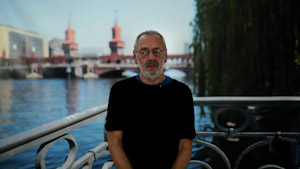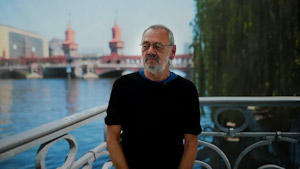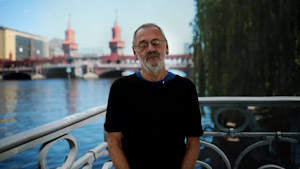"We used the Wall as a form of protection."
The former border strip at the East Side Gallery laid fallow after the Berlin Wall opened. In 1991, people began moving to the empty grounds and living in run-down vehicles and converted construction trailers. A West Berlin trailer camp that had been forced to vacate its location in Berlin-Mitte was the first to move to the empty site. Another group set up a camp near the Oberbaum Bridge, bringing along chickens, goats and other animals. Other individuals from Berlin, other parts of Germany and elsewhere, settled in another spot between these two communities. These transients included new arrivals to the city, young runaways and creatives. The Wall offered a bit of protection from the "outside" world and shielded the residents from the gazes of onlookers and the police. But the 1.3 km long Wall also hindered the residents from going about their everyday business. To avoid having to walk all the way around the barrier, they made a hole in the Wall. The opening, which still exists, is the only reminder of the trailer camp.

"The East Side was the place, where the outcasts lived"

More than 250 people lived in the trailer camp, which came to be known as the “East Side Wagenburg.” Because it had become so large, organizing communal life through plenums, as was customary, was no longer possible. The East Side Wagenburg became Berlin's most socially disadvantaged trailer camp, which led to conflicts. By 1994, a few sanitary facilities had been added, but there was still no access to running water or electricity. The press reported negatively on the conditions at the site and on crime and drug trafficking there. In 1996, when newspapers wrote about a murder on the grounds and a suspected case of tuberculosis, media and politicians began pushing more strongly for the area to be vacated. The residents of the East Side Wagenburg were evicted by the Berlin Senator for Internal Affairs on 17 July 1996.
"The people who lived at the Wagenburg were actually like on an island."

What are trailer camps?
“It was different than living in a communal house or a shared flat. This was a different category altogether.”
People have different reasons for living in a trailer camp. Some trailer camps provide shelter to people who are excluded from society. They provide a home to people affected by racism, sexism, poverty, homelessness, and family problems. Other trailer camps become a home to people who view themselves as dropouts from society or who believe in the democratic constitution of a small community. They are looking for a self-determined lifestyle that exists beyond the dictates of the housing market. Some residents see the trailer camps as a different form of living, or an alternative to living in a shared flat. Others simply want to live closer to nature. A common characteristic of trailer camps is the communal support in all aspects of life.
Trailer camps differ in their political aspirations, their level of organization, and in the income and education levels of the residents. Most trailer camps consist of a common area occupied by mostly disused trailers and vehicles. Social coexistence in trailer camps is characterized by collective plenary decisions, for example on who gets to move in. An indispensable feature of trailer camps is the solidarity among members. Today, many trailer camps are connected to the urban infrastructure and have access to water and electricity.
“The social aspect was very important. We always said that no one needed to steal here. There was always enough food for everyone. There was always a place to sleep. That simply wasn’t an issue.”
Trailer Camps and the Berlin Wall
The first trailers camps were established in the early 1980s, mostly in connection with squatting projects. A few trailer camps existed near the Berlin Wall before the border opened, such as the one at Potsdamer Platz. After 9 November 1989, new trailer camps emerged along the empty former border strip. When the vacant lots were sold to investors, the trailer camp residents were forced to leave. Today, trailer camp residents continue to fight for their open spaces and engage in negotiations with the Berlin government, district administrations and property owners. There are currently more than 12 trailer camps in Berlin.
Contemporary witnesses remember
The Lohmühle trailer camp was established in Berlin-Treptow in 1991 and has its own website:
Whose city is it?





















